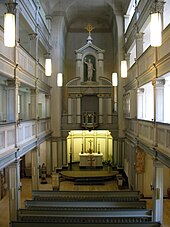Maria Schmidt
Auguste Maria Clara Schmidt , married Auguste Baum , (born September 28, 1807 in Weimar ; † March 12, 1875 ibid) was a German actress, opera singer (soprano) and harp player who appeared as Madame Baum after 1835 .
Life
Maria Schmidt was the only child of the Weimar court musician Carl Schmidt (* 1777 in Tannroda , † 1858 in Weimar) and granddaughter of Johann Nicolaus Ambrosius, also court musician in Weimar. Maria Schmidt received her musical education (piano, harp , singing) from her father, the first bassoonist of the Weimar court orchestra , and from the chamber singer Karl Melchior Jakob Moltke ( tenor , 1783–1831), member of the so-called Weimar Quartet .
Maria Schmidt already appeared as a harp soloist in 1822. In 1823 she made her debut at the court theater as Ännchen in Der Freischütz by Carl Maria von Weber (1786–1826) and in 1824 sang the leading role Euryanthe in the Weimar premiere of Weber's opera of the same name . In 1835 Maria Schmidt married the “Kaufmann Baum” and made her debut in Weimar under her new name with the role of Zerlina in Fra Diavolo by Daniel-François-Esprit Auber (1782–1872) as “Madame Baum”. This was followed by engagements in Hanover , Oldenburg (Oldenburg) and Dessau , where she appeared in 1836/37 under the direction of the actor and entertainer Heinrich Eduard Bethmann .
Until her retirement in 1858 she was back in Weimar on stage and sang there on June 27, her farewell performance as Salome in the Saalnixe by Ferdinand Kauer (1782-1871) Donauweibchen . For the “Miss. Baum ”in the role of Hulda, the hall mermaid , there are references to the actress and singer (soprano) Melanie Baum , who was trained by Milde , made her debut at the Weimar Court Theater in 1856 , but there is no sufficient passage in the text to indicate that it is a daughter of Maria (Schmidt -) Tree acts.
Stage roles (selection)
- Ännchen in Der Freischütz by Carl Maria von Weber
- Euryanthe in Euryanthe by Carl Maria von Weber
- Zerlina in Fra Diavolo by Daniel-François-Esprit Auber
- Zerlina in Don Giovanni by Wolfgang Amadeus Mozart
- Konstanze in The Abduction from the Seraglio by Wolfgang Amadeus Mozart
- Rosina in The Barber of Seville by Gioachino Rossini
- Madeleine in The Postillon of Lonjumeau by Adolphe Adam
- Salome in the Saalnixe by Karl Friedrich Hensler's Donauweibchen of Christian August Vulpius , music by Ferdinand Kauer
reception
Ludwig Eisenberg in particular describes Maria Schmidt as a particularly versatile artist: her beautiful, artfully performed soprano voice, suitable for the major roles in the coloratura subject , her skillful playing in the youthful, naive parts, in later years the expressive singing in tragic roles . But later on she also delighted the audience as a so-called “comical old woman”, and her concerts as a virtuoso harp soloist met with great admiration. Goethe dedicated the poem To the Actress Marie Schmidt to her :
The beautiful valley has the sun again
Filled with spring blossoms and flowers,
The nightingale always sings new songs
The exhilaration that flows towards you;
Rejoice in the God-given gifts!
Glad how he created you, he wants you.
literature
- Ludwig Eisenberg : Large biographical lexicon of the German stage in the XIX. Century . Verlag von Paul List , Leipzig 1903, p. 896, ( Textarchiv - Internet Archive ).
- Maria Schmidt. In: Deutsche Biographische Enzyklopädie, Volume 9 , edited by Rudolf Vierhaus, Verlag Walter de Gruyter, 2008, ISBN 978-3-11-096502-5 , p. 49, also: Google Books
Web links
- Maria Schmidt in the Carl Maria von Weber Complete Edition
- Maria Schmidt at Operissimo on the basis of the Great Singer Lexicon
Individual evidence
- ↑ according to the baptism entry Hofkirche. At WeGA September 8 and November 8, 1808 each, at Ludwig Eisenberg November 8, 1808.
- ↑ according to WeGA
- ↑ Reference to the illustration together with the actor Eduard Franz Genast in the history of the Weimar theater from its beginnings to today. P. 282, List of Figures
- ↑ according to the Hofkirche church book
- ^ New Nekrolog der Deutschen by Friedrich August Schmidt, p. 174. and letter contact with Goethe
- ↑ Allgemeine Musikalische Zeitung , Volume 24, August 1822, pp. 576–577. at Google Books
- ^ Organ for autograph collectors and autograph dealers
- ^ Digital archive of the Thuringian State Archives
- ↑ Complete Works, Volume 36, Verlag G. Müller, 1823, p. 336
Remarks
- ↑ Berliner Musikzeitung p. 351. , Neue Zeitschrift für Musik p. 258. , A. Heinrich's deutscher Bühnen-Almanach p. 373–377. Neue Zeitschrift für Musik p. 41. , Staats Handbuch von 1859, pp. 70–71. , Neue Zeitschrift für Musik p. 192. Genast diary p. 289. Liszt's memories p. 110.
| personal data | |
|---|---|
| SURNAME | Schmidt, Maria |
| ALTERNATIVE NAMES | Schmidt, Auguste Maria Clara (full name); Baum, Auguste; Tree, madame; Tree, Marie |
| BRIEF DESCRIPTION | German actress, opera singer (soprano) and harp player |
| DATE OF BIRTH | September 28, 1807 |
| PLACE OF BIRTH | Weimar |
| DATE OF DEATH | March 12, 1875 |
| Place of death | Weimar |



